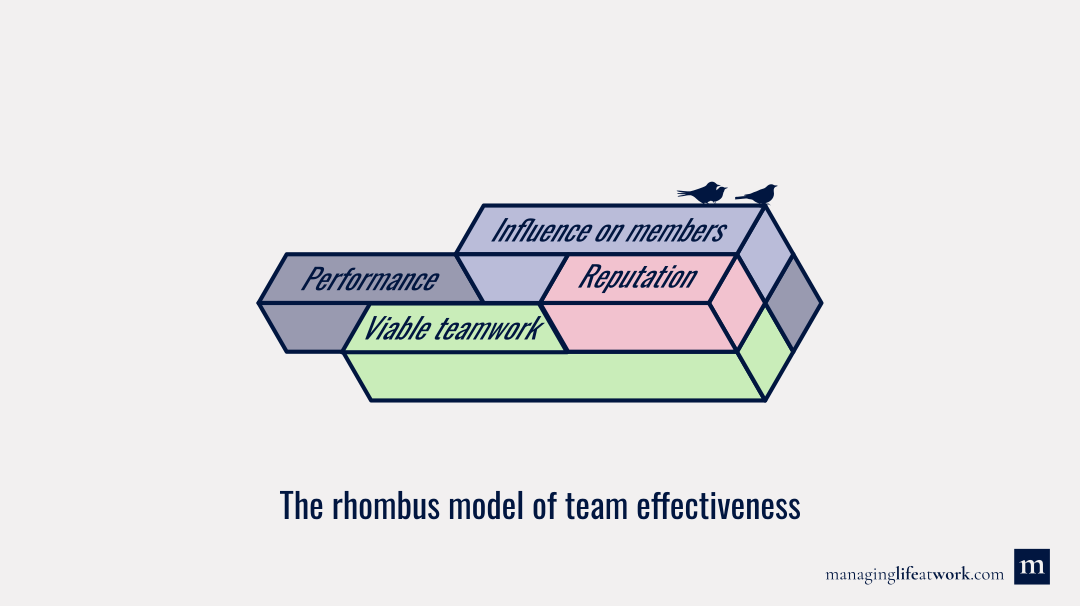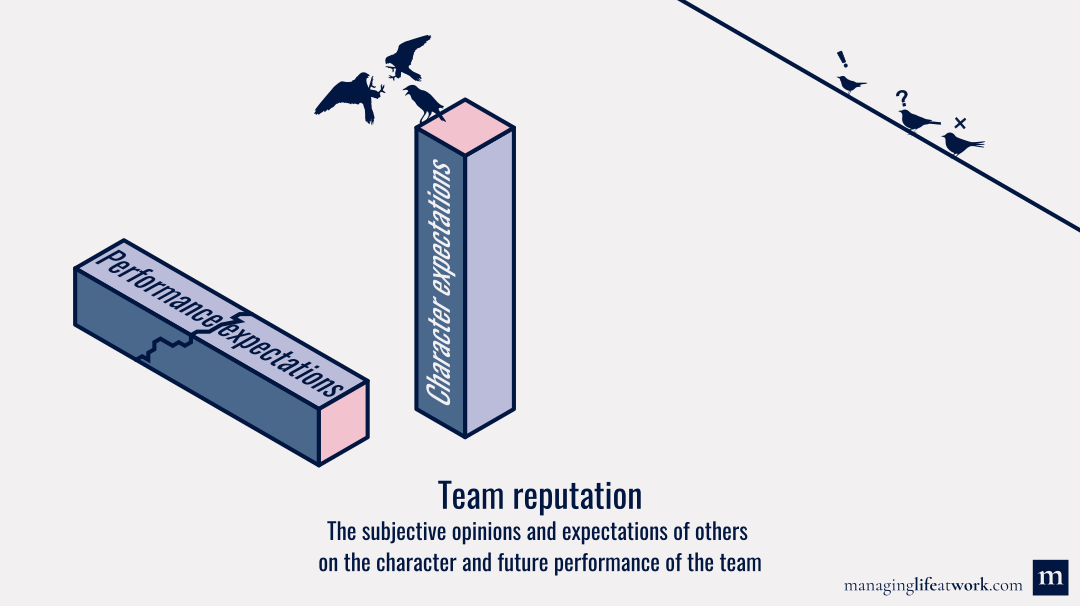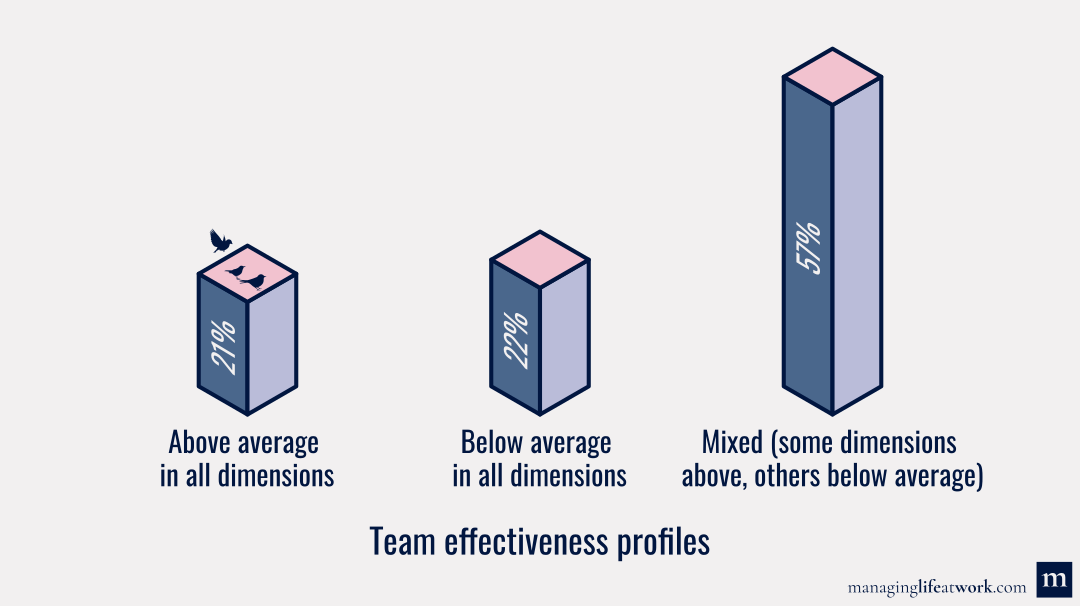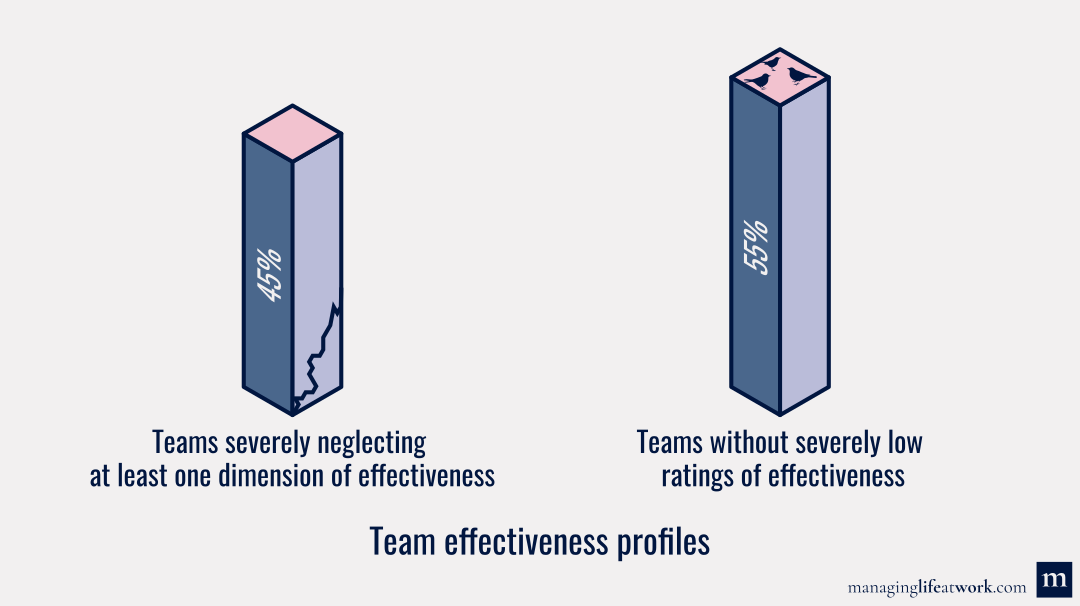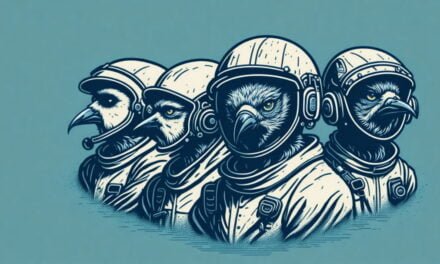Team effectiveness must be clearly defined, delineated, measured, and rewarded if you want to give your team a fair chance of being effective at work.
Interestingly, in our years working with teams to improve their effectiveness, when we ask “what is team effectiveness?” there is either an awkward silence or answers that only cover part of what team effectiveness actually is. Many teams are simply not knowledgeable of what effectiveness actually means for them. It thus comes as no surprise that we have seen many teams failing to improve or even sustain their effectiveness.
To improve your probability of working in or leading an effective team, we set out to define team effectiveness, identify its key dimensions, and outline examples of measures for team effectiveness. We also ran a survey study to give you an idea of how many teams are actually being effective.
What is team effectiveness?
Team effectiveness is defined as the extent to which a team meets the expectations (for example, goals, objectives, deliverables, and by-products) of relevant constituencies from within and outside the team and the organization (such as team members, direct supervisors, top managers, other teams, suppliers, and customers).
This definition highlights the two most important aspects that every team should consider while thinking about, delineating, or measuring team effectiveness.
First, it suggests that team effectiveness encompasses a set of different, but related, dimensions[1] [2] [3]. Team performance, team viability, team satisfaction, and team reputation are some dimensions of effectiveness. Team effectiveness is thus multidimensional and multifaceted.
Second, the definition also suggests that team effectiveness can mean different things to different people[4] [5]. For instance, team members may emphasize how satisfied they are with the team. In contrast, leaders may focus on performance, and customers may care mostly for how reputable a team is. Depending on your relationship with or positioning within the team, you may weight each dimension of team effectiveness differently.
In practical terms, your team is an effective one if it is able to identify the effectiveness dimensions that are most relevant for both internal and external constituencies, as well as to satisfy their expectations on each dimension of effectiveness.
Dimensions and measures of team effectiveness
Team effectiveness can be organized as a three-level hierarchical structure[6] [7]. At the top lie the global dimensions of team effectiveness. These include several specific dimensions, each assessed with well-developed measures.
The global dimensions give you a big picture of the core aspects that tend to be important for the effectiveness of most teams[2] [8]. The specific dimensions give you a range of manifestations that allow you to delineate and further define each global dimension of team effectiveness. The measures of team effectiveness are the methods used to evaluate how effective your team is on each dimension (global or specific).
The specific dimensions and measures you use to delineate and assess team effectiveness largely depend on aspects like the type of work your teams does[9]. For example, in your team the key aspect of interest for team performance (global dimension) might be productivity (specific dimension), as assessed by the number of closed sales (measure).
Global dimensions of team effectiveness
There are numerous models of team effectiveness, each one highlighting a different set of global dimensions. For instance, Sundstrom’s team effectiveness model focuses on performance (degree of fit between the team’s output and recipients’ expectations) and viability (members’ satisfaction with and willingness to keep working in the team)[7] [10].
Mathieu’s model of team effectiveness also consists of two global dimensions: performance (including productivity, quality, and efficiency), and influences on team members (including team states like cohesion and psychological safety, as well as individual outcomes such as turnover and absenteeism)[3] [6].
Other models consider three global dimensions of team effectiveness. Hackman’s model of team effectiveness focuses on performance (including expected standards of quantity, quality, and service), viability (the extent to which team members are willing to work together in the future, and how much is the team improving as a result of the collaborative work), and team members’ growth and well-being (how much team members are growing, learning and achieving their goals while working in the team)[2].
Similarly, Cohen and Bailey’s model suggests that team effectiveness is defined by three global dimensions: performance (including the quality, quantity, and innovativeness of team’s outputs), members’ attitudes (including how satisfied and committed team members are); and members’ behaviors (for example, levels of absenteeism and turnover)[9].
Although each model highlights different global dimensions of team effectiveness, all models have something in common. In all cases, team effectiveness is not a synonym of team performance (the latter is only a component, facet, or dimension of the first). Team performance is of critical importance to virtually all teams[1], but if your team wants to sustain long term effectiveness it will have to consider other global dimensions.
The rhombus model of team effectiveness
In our years training and researching teams, we have found that team effectiveness tends to be more sustainable over time when teams attend to four global dimensions:
- Performance (including efficiency, productivity, quality, and innovation);
- Viable teamwork (including teamwork quality, process improvement through learning, ability to continue working together as a team, and ability to deal with difficulties);
- Team’s influence on members (including team members’ well-being, growth, and development, and the influence teamwork has on team members’ behaviors and attitudes);
- Reputation (including outsiders’ impressions of the team).
According to the rhombus model of team effectiveness, effective teams perform as expected (performance), prosper over time (viability), support members’ growth and learning (influence on members), and are credible to others outside the team (reputation).
These four dimensions tend to be a source of sustainable competitive advantage for two main reasons. First, they address the effectiveness expectations of most teams’ constituencies. For instance, performance is particularly important for team supervisors and top management, reputation for clients and other teams in the company, viable teamwork for the team as a whole, and team’s influence on members for each individual team member. Sacrificing one of these dimensions will likely frustrate the expectations of people who are important for your team.
Second, research has shown that these four dimensions sustain one another over time. For instance, teams with viable teamwork in place tend to perform better, and high performing teams tend to see themselves as viable[8] [11] [12]. Likewise, teams with burned out members tend to see decreases in performance[13], and sub-optimal performance can lead to additional teamwork demands that further reduce team members’ well-being[14]. The relative importance of each dimension may change due to circumstances, but teams who are able to consistently sustain their effectiveness never fully ignore one of these dimensions.
Specific dimensions and measures of team effectiveness
Specific dimensions of team effectiveness are used to further define and delineate each global dimension of team effectiveness[6]. For instance, depending on the type of work your team does, you may appraise team performance based on the quality of a product or service, the productivity of your team, and/or the number of innovations implemented.
In turn, measures of team effectiveness are the most fine-grained delineations of team effectiveness. They tell your team what really matters, give concrete goals for your team to adhere to, and provide the information that is necessary to assess how effective your team is. For instance, the focus of your team might vary depending on whether you measure productivity with the number of calls made to try to sell something or with the number of actual closed sales.
Let’s look at the specific dimensions and corresponding measures that are most commonly used to appraise each global dimension of team effectiveness.
Team performance
Here are the most commonly used measures for each specific dimension of team performance:
- Productivity is the number of deliverables a team produces over a given period of time (illustrated by statements such as “This month we made 100 sales”).
- Productivity measures – number of closed sales, pieces produced, articles written, clients served, calls made, customer response times, financial ratios (such as return on investment, return on assets, net worth to total assets, market share).
- Efficiency is the team’s productivity compared to a given standard, expectation, or benchmark. If you say something like “This month we increased our productivity by 10%” you are saying that your team was more efficient this month, compared to last month.
- Efficiency measures – sales growth, adherence to budgets and schedules, speed-to-market, queue time reduction, call duration reduction, reduction of materials used to produce a given number of pieces, reduction of time to write an article, increased return on investment, increased market share.
- Quality is the value and worth attributed to a team’s output by those who receive it (for example, “Our customer satisfaction survey indicated that 90% of our customers saw their needs met with our product”).
- Quality measures – customer satisfaction; customer complain rates; product return rates; error/failure rates; rate of flagged products, services, or processes by quality control analyses.
- Innovation is the generation and implementation of ideas that are both new and potentially useful for those who receive the team’s output[16]. If you state something like “During our team meeting we discussed new product ideas” you are talking about the first stage of innovation, idea generation or team creativity. If you say “Last week we launched a new line of products” you are describing the end result of the implementation process undertaken to turn creative ideas about a line of products into reality.
- Innovation measures – number of creative ideas generated, number of new products or services launched, number of patents, number of technical reports, ratio of ideas implemented to ideas developed, level of proficiency with a new product or service.
Viable teamwork
Viable teamwork is the extent to which a team has in place the processes and states necessary to achieve its goals, to improve daily, and to boost its ability to deal with obstacles. This dimension of team effectiveness focuses on how well the dynamics of the team are functioning.
Here are the three main specific dimensions of viable teamwork and their corresponding measures:
- Team processes covers how team members get along and the way they work together to achieve collective goals[17]. Overall, processes are about the behaviors, actions, and interactions that you see in a team. If you say something like “We had a productive meeting to define the next quarter goals”, you are talking about a team process.
- Team processes measures – Gantt charts assessing how well the team is progressing toward goals, ratio of coordination failures to successes, rate of role overlap among members, rate of personal clashes in the team, ratio of time spent in meetings to coordination returns, ratio of cooperation to competition, helping behaviors, anonymous surveys on key team processes.
- Team states (also called team emergent states) are the thoughts, feelings and motivations shared among the members of the team[18] (an example could be a statement such as “We are confident that our team will meet the next quarter goals”).
- Team states measures – anonymous surveys on, for example, how clear and committed team members are to goals, how safe members feel in sharing ideas, and how much teammates trust one another. Indirect measures can also be informative, such as ratio of team lunch invitations to number of members present (as an indication of cohesion), and intense signs of frustration to day-to-day challenges (as an indication of a negative social climate).
- Team viability is the extent to which the team as a whole can deal effectively with the challenges that may impair its stability and longevity[19].
- Team viability measures – team tenure, level of stability in membership, how easily are new members integrated in the team, success-failure ratio of the team, response time of adaptation to unexpected changes in the team’s environment, level of improvement or deterioration of team processes through time.
Team’s influence on members
The main specific dimensions of team’s influence on members and respective measures are below.
- Team members’ attitudes and behaviors refer to the impact teamwork has on how members view the team and on how they act at work.
- Measures of attitudes and behaviors – turnover rates, unjustified absenteeism, social loafing prevalence, horizontal transfer rates (move to a similar team in the organization), tardiness rates, grievance rates, anonymous surveys on job satisfaction and commitment to the team, level of safety measures adoption, injury/accident rates.
- Team members’ well-being is the extent to which the team provides opportunities and conditions for the optimal psychological functioning of its members. This means that team members are both happy to work in the team and look forward to each new day because they believe they are in the process of reaching their full potential.
- Measures of well-being – sick leave rates; sickness absenteeism rates; presenteeism rates (working while ill); burnout rates; changes in insurance and medical costs due to deterioration of team members’ psychological well-being and physical health; rates of substance abuse; rates of premature retirement; pace of health and psychological recovery; anonymous surveys on how happy, enthused, and energized team members are, as well as how well their psychological needs are being satisfied or frustrated.
- Team members’ professional growth refers to whether the work in the team is a source of opportunities for team members to develop and grow professionally, expand skills, and learn continuously.
- Measures of professional growth – number of formal certifications each member has, level of autonomy of team members, pace of career progression in the company.
Team reputation
Team reputation covers the subjective opinions of others on the character and value of the team, and the expectations others have on the future behavior and performance of the team[20] [21] [22]. When third parties (like clients) have contact with your team, they develop a sense of what is happening inside the team and of what the team is doing. Third parties can pick up signals on, for example, how well members get along, whether a team should be trusted, the quality of work produced, and how ethically things are being achieved. Based on this information, third parties ascribe a reputation to a team and develop a set of expectations for future work, interactions, and values.
Below are the two most common specific dimensions of team reputation and corresponding measures.
- Team character expectations captures the integrity, honesty, and trustworthiness of the team, as seen by third parties.
- Measures of team character expectations – anonymous surveys on the integrity of the team (from other teams and clients, for example), ability to attract highly talented team members, assessment of the integrity of those with whom the team is associated, perceived environmental and social responsibility of the team.
- Team performance expectations captures the extent to which third parties consistently expect the highest quality, efficiency, productivity, and innovativeness from the team.
- Measures of team performance expectations – level of repeated business (such as repeated sales), number of new clients coming from word of mouth, ranking position in transparent and honest reviews, social media comments on the quality of products and services.
How effective are teams? Results of a survey study
To better understand how effective teams are, we surveyed 96 team supervisors, and asked them to rate their teams on the four global dimensions of the rhombus model of effectiveness: performance, viable teamwork, influence on members, and reputation. Team supervisors were from the US and worked on multiple sectors (for example, management, finance, engineering, education).
We found that 21% of teams were truly effective, as they were rated above average in all global dimensions of effectiveness. We also found that 22% of teams were rated below average in all dimensions, and that 57% had mixed profiles (that is, with some dimensions above and others below average). Thus, 79% of teams had sub-optimal ratings in one or more dimensions of effectiveness.
However, not all teams with below average ratings are at risk of failing. For example, a team may have a sub-optimal rating because it is learning how to deal with an unforeseen change in the environment, or strategically focusing on one dimension of effectiveness over another due to a deadline.
To better understand how many teams were actually at risk of jeopardizing their long-term success, we checked how many were severely neglecting at least one dimension of effectiveness. We found that 45% of teams were rated extremely low in, at least, one global dimension of effectiveness (that is, they were rated below percentile 25 in at least one dimension). This tells us that, in real life, almost half of the teams out there may be largely unsuccessful or are at risk of becoming unsuccessful because they are overlooking one or more pillars of their effectiveness.
Conclusion
Teamwork is here to stay and we should use the best available knowledge to make it more effective and pleasant to all people involved in or impacted by it. Rather than being daunted by all the dimensions and measures of team effectiveness available out there, we have structured that information so you can become knowledgeable on team effectiveness. We defined team effectiveness, outlined the rhombus model of team effectiveness, and identified its key dimensions and corresponding measures.
Team effectiveness is complex, as well as subject to luck and random events outside of your team’s control. However, there are still things we can do to enhance our probabilities of success. We hope the information and accumulated knowledge we shared in this article contribute to your team’s enhanced effectiveness.
In case you want to learn more on how to improve the effectiveness of your team, check our 5-step guide here.
As always, we thank you for trusting your time with ManagingLifeatWork.com. Until next time, keep improving the probability of enhancing the effectiveness of your team, and good luck!
References and further reading
- ^ a b Aubé, C., and Rousseau, V. (2011). “Interpersonal aggression and team effectiveness: The mediating role of team goal commitment“. Journal of Occupational and Organizational Psychology, 84, 565–580.
- ^ a b c d Hackman, J. R., and Wageman, R. (2005). “A theory of team coaching“. Academy of Management Review, 30, 269–287.
- ^ a b c Mathieu, J. E., Gallagher, P. T., Domingo, M. A., and Klock, E. A. (2019). “Embracing complexity: Reviewing the past decade of team effectiveness research“. Annual Review of Organizational Psychology and Organizational Behavior, 6, 17–46.
- ^ Lemieux-Charles, L., Murray, M., Baker, G. R., Barnsley, J., Tasa, K., and Ibrahim, S. A. (2002). “The effects of quality improvement practices on team effectiveness: A mediational model“. Journal of Organizational Behavior, 23, 533–553.
- ^ Singh, A. K., and Muncherji, N. (2007). “Team effectiveness and its measurement: A framework“. Global Business Review, 8, 119–133.
- ^ a b c Mathieu, J. E., and Gilson, L. L. (2012). “Criteria issues and team effectiveness“. In S. W. J. Kozlowski (Ed.), Oxford Handbook of Industrial and Organizational Psychology (pp. 910–930). London, UK: Oxford University Press.
- ^ a b Sundstrom, E., McIntyre, M., Halfhill, T., and Richards, H. (2000). “Work groups: From the Hawthorne studies to work teams of the 1990s and beyond“. Group Dynamics: Theory, Research, and Practice, 4, 44–67.
- ^ a b Aubé, C., and Rousseau, V. (2005). “Team goal commitment and team effectiveness: The role of task interdependence and supportive behaviors“. Group Dynamics: Theory, Research, and Practice, 9, 189–204.
- ^ a b c d Cohen, S. G., and Bailey, D. E. (1997). “What makes teams work: Group effectiveness research from the shop floor to the executive suite“. Journal of Management, 23, 239–290.
- ^ Sundstrom, E., De Meuse, K. P., and Futrell, D. (1990). “Work teams: Applications and effectiveness“. American Psychologist, 45, 120–133.
- ^ Barrick, M. R., Stewart, G. L., Neubert, M. J., and Mount, M. K. (1998). “Relating member ability and personality to work-team processes and team effectiveness“. Journal of Applied Psychology, 83, 377–391.
- ^ Mathieu, J. E., Kukenberger, M. R., D’Innocenzo, L., and Reilly, G. (2015). “Modeling reciprocal team cohesion–performance relationships, as impacted by shared leadership and members’ competence“. Journal of Applied Psychology, 100, 713–734.
- ^ Bakker, A. B., Van Emmerik, H., and Van Riet, P. (2008). “How job demands, resources, and burnout predict objective performance: A constructive replication“. Anxiety, Stress & Coping, 21, 309–324.
- ^ a b Ogbonnaya, C. (2019). “Exploring possible trade‐offs between organisational performance and employee well‐being: The role of teamwork practices“. Human Resource Management Journal, 29, 451–468.
- ^ Kozlowski, S. W. J., and Ilgen, D. R. (2006). “Enhancing the effectiveness of work groups and teams“. Psychological Science in the Public Interest, 7, 77–124.
- ^ Stollberger, J., West, M. A., and Sacramento, C. A. (2019). “Innovation in work teams“. In P. B. Paulus & B. A. Nijstad (Eds.), The Oxford Handbook of Group Creativity and Innovation (pp. 230–251). Oxford University Press.
- ^ Mathieu, J. E., Luciano, M. M., D’Innocenzo, L., Klock, E. A., and LePine, J. A. (2020). “The development and construct validity of a team processes survey measure“. Organizational Research Methods, 23, 399–431.
- ^ Marks, M. A., Mathieu, J. E., and Zaccaro, S. I. (2001). “A temporally based framework and taxonomy of team processes“. Academy of Management Review, 26, 356–376.
- ^ Rousseau, V., and Aubé, C. (2010). “Team self-managing behaviors and team effectiveness: The moderating effect of task routineness“. Group & Organization Management, 35, 751–781.
- ^ Laird, M. D., Zboja, J. J., and Ferris, G. R. (2012). “Partial mediation of the political skill‐reputation relationship“. Career Development International, 17, 557–582.
- ^ Peralta, C. F., Lourenço, P. R., Lopes, P. N., Baptista, C., and Pais, L. (2018). “Team development: Definition, measurement and relationships with team effectiveness“. Human Performance, 31, 97–124.
- ^ a b Tyran, K. L., and Gibson, C. B. (2008). “Is what you see, what you get? The relationship among surface- and deep-level heterogeneity characteristics, group efficacy, and team reputation“. Group & Organization Management, 33, 46–76.



